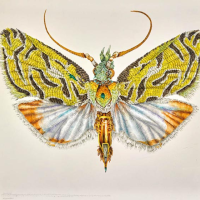25. EX DE MEDICI

The diverse and sophisticated practice of enigmatic Canberra-based artist, eX de Medici, encompasses striking variations in subject matter, which she combines in unexpected and challenging ways.
Although examples such as Hideous Human Angel #7 draw on historical items from the CSIRO Entomology Divisions Australian National Insect Collection, the result is strikingly contradictory and contemporary, as the title of the work suggests. Here the artist cloaks a skilful fusion of biology and weaponry in the luxuriant and delicately rendered pelt of the moth, as its furry covering is termed.
During her time as an Artist Fellow at the Australian National Insect Collection, de Medici concentrated her energies on Microlepidoptera, necessitating the use of a microscope to observe and record the moths distinctive markings. The insects she studied were unclassified by scientists and in many cases extinct, often coming from areas where their habitat had been destroyed by mining and other human activities harmful to the environment.
These once-living beings are unknown and unknowable, both because of their size and the paucity of research on them, including information about how they reproduce. Here the imagination of the artist takes over, replacing the insects reproductive organs with elements of firearms and transforming these seemingly innocuous creatures into pieces of sophisticated weaponry much like microscopic versions of drones used in modern warfare.
The result is a masterful contrast between the resplendent pelt of the moth in all its seductive fragility and the sophisticated weaponry which constitutes the sting in its tail. When viewed in this context, the antennae and proboscis assume a more menacing aspect and the moths delicately rendered patterning begins to resemble camouflage.
The artist admits to being preoccupied with force and the exercise of power, saying I find the whole premise of power and violence utterly overwhelming; I think thats why Im obsessed with it.1 Other explorations of these issues include watercolours depicting guns with the downy coverings of moths and work developed from a stint in the Solomon Islands as an Official War artist recording the activities of the Australian Peacekeeping Mission.
The simultaneous beguiling and repellent nature of eX de Medicis watercolours is far removed from the sedate practice of nineteenth century natural history painting, an effect which is intensified by her rendering of such small insects on a large scale. What results is miniaturism writ large, with the works developing a formal quality reminiscent of an emblem or insignia, a symbolic object which has potency and meaning in its own right.
Much in the way that the moths pelt cloaks the hard edges of the military imagery which the artist employs, de Medicis use of watercolour, a medium traditionally regarded as being rather staid, entices viewers to engage with the complicated and highly charged concepts she is expressing.
Ryan Johnston, Head of Art at the Australian War Memorial, observes that it is a conservative medium and it is like a velvet glove approach almost. The idea is to have these beautiful watercolours, which seduce you into what becomes a very loaded and very complex social and political commentary.2
In these beguiling and multi-layered works, de Medici uses a traditional medium to inject new meaning into historical materials and in doing so creates a very contemporary work of art. The artists innovative and imaginative engagement with natural history painting, a genre generally associated with the past, has produced an astute commentary on both the present and the future, with reference to very modern concerns about technology, conflict and the environment.
1. The artist quoted in Paul Flynn, Ex de Medici, Artist Profile, issue 5, 2 March 2008, accessed 21 May 2016, https://sullivanstrumpf.com/assets/Uploads/Flynn-Paul.pdf.
2. The artist quoted in Bronwyn Watson, ex de Medici mixes the conservative with the contemporary, The Australian, 19 April 2014, accessed 21 May 2016, http://www.theaustralian.com.au/arts/review/ex-de-medici-mixes-the-conservative-with-the-contemporary/story-fn9n8gph-1226885421329.
Anne Phillips BA (Hons), MA